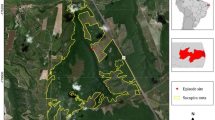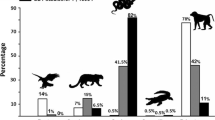Abstract
Snakes present a hazard to primates, both as active predators and by defensive envenomation. This risk might have been a selective pressure on the evolution of primate visual and cognitive systems, leading to several behavioral traits present in human and non-human primates, such as the ability to quickly learn to fear snakes. Primates seldom prey on snakes, and humans are one of the few primate species that do. We report here another case, the wild capuchin monkey (Sapajus libidinosus), which preys on snakes. We hypothesized that capuchin monkeys, due to their behavioral plasticity, and cognitive and visual skills, would be capable of discriminating dangerous and non-dangerous snakes and behave accordingly. We recorded the behavioral patterns exhibited toward snakes in two populations of S. libidinosus living 320 km apart in Piauí, Brazil. As expected, capuchins have a fear reaction to dangerous snakes (usually venomous or constricting snakes), presenting mobbing behavior toward them. In contrast, they hunt and consume non-dangerous snakes without presenting the fear response. Our findings support the tested hypothesis that S. libidinosus are capable of differentiating snakes by level of danger: on the one hand they protect themselves from dangerous snakes, on the other hand they take opportunities to prey on non-dangerous snakes. Since capuchins and humans are both predators and prey of snakes, further studies of this complex relationship may shed light on the evolution of these traits in the human lineage.


Similar content being viewed by others
References
Boinski S (1988) Use of a club by a wild white-faced capuchin (Cebus capucinus) to attack a venomous snake (Bothrops asper). Am J Primatol 14:177–179. doi:10.1002/ajp.1350140208
Butynski TM (1982) Vertebrate predation by primates: a review of hunting patterns and prey. J Hum Evol 11:421–430. doi:10.1016/s0047-2484(82)80095-x
Cardoso RM, Ottoni EB (2016) The effects of tradition on problem solving by two wild populations of bearded capuchin monkeys in a probing task. Biol Lett 12:20160604. doi:10.1098/rsbl.2016.0604
Cisneros-Heredia DF, Cisneros-Heredia DF, León-Reyes A et al (2005) Boa constrictor predation on a titi monkey, Callicebus discolor. Neotrop Primates 13:11–12. doi:10.1896/1413-4705.13.3.11
Cook M, Mineka S (1989) Observational conditioning of fear to fear-relevant versus fear-irrelevant stimuli in rhesus monkeys. J Abnorm Psychol 98:448–459. doi:10.1037/0021-843X.98.4.448
Crofoot MC (2012) Why mob? Reassessing the costs and benefits of primate predator harassment. Folia Primatol 83:252–273. doi:10.1159/000343072
de Queiroga Cavalcanti LB, Costa TB, Colli GR et al (2014) Herpetofauna of protected areas in the Caatinga. II. Serra da Capivara National Park, Piauí, Brazil. Check List 10:18–27
Digweed S, Fedigan L, Rendall D (2005) Variable specificity in the anti-predator vocalizations and behaviour of the white-faced capuchin, Cebus capucinus. Behaviour 142:997–1021. doi:10.1163/156853905774405344
Emile N, Barros M (2009) Recognition of a 3D snake model and its 2D photographic image by captive black tufted-ear marmosets (Callithrix penicillata). Anim Cogn 12:725–732. doi:10.1007/s10071-009-0234-z
Falótico T (2011) Uso de ferramentas por macacos-prego (Sapajus libidinosus) do Parque Nacional Serra da Capivara—PI. Thesis, University of São Paulo. doi: 10.11606/T.47.2011.tde-04112011-171428
Falótico T, Ottoni EB (2013) Stone throwing as a sexual display in wild female bearded capuchin monkeys, Sapajus libidinosus. PLoS ONE 8:e79535. doi:10.1371/journal.pone.0079535
Falótico T, Ottoni EB (2014) Sexual bias in probe tool manufacture and use by wild bearded capuchin monkeys. Behav Process 108:117–122. doi:10.1016/j.beproc.2014.09.036
Falótico T, Ottoni EB (2016) The manifold use of pounding stone tools by wild capuchin monkeys of Serra da Capivara National Park, Brazil. Behaviour 153:421–442. doi:10.1163/1568539X-00003357
Fedigan LM (1990) Vertebrate predation in Cebus capucinus: meat eating in a Neotropical monkey. Folia Primatol 54:196–205. doi:10.1159/000156444
Fragaszy DM, Visalberghi E, Fedigan LM (2004) The complete capuchin: the biology of the genus Cebus. Cambridge University Press, Cambridge
Freitas MA (2003) Serpentes brasileiras. Malha-de-Sapo, Lauro de Freitas
Headland TN, Greene HW (2011) Hunter-gatherers and other primates as prey, predators, and competitors of snakes. Proc Natl Acad Sci USA 108:E1470–E1474. doi:10.1073/pnas.1115116108
Isbell LA (2006) Snakes as agents of evolutionary change in primate brains. J Hum Evol 51:1–35. doi:10.1016/j.jhevol.2005.12.012
Isbell LA (2009) The fruit, the tree, and the serpent. Harvard University Press, Cambridge
Isbell LA, Etting SF (2017) Scales drive detection, attention, and memory of snakes in wild vervet monkeys (Chlorocebus pygerythrus). Primates 58:121–129. doi:10.1007/s10329-016-0562-y
Kawai N, Koda H (2016) Japanese monkeys (Macaca fuscata) quickly detect snakes but not spiders: evolutionary origins of fear-relevant animals. J Comp Psychol 130:299–303. doi:10.1037/com0000032
Maior RS, Hori E, Barros M et al (2011) Superior colliculus lesions impair threat responsiveness in infant capuchin monkeys. Neurosci Lett 504:257–260. doi:10.1016/j.neulet.2011.09.042
Mannu M, Ottoni EB (2009) The enhanced tool-kit of two groups of wild bearded capuchin monkeys in the Caatinga: tool making, associative use, and secondary tools. Am J Primatol 71:242–251. doi:10.1002/ajp.20642
Martin P, Bateson P (2007) Measuring behaviour: an introductory guide, 3rd edn. Cambridge University Press, Cambridge
McGrew WC (2015) Snakes as hazards: modelling risk by chasing chimpanzees. Primates 56:107–111. doi:10.1007/s10329-015-0456-4
Mendonça-Furtado O, Edaes M, Palme R et al (2014) Does hierarchy stability influence testosterone and cortisol levels of bearded capuchin monkeys (Sapajus libidinosus) adult males? A comparison between two wild groups. Behav Process 109:79–88. doi:10.1016/j.beproc.2014.09.010
Meno W, Coss RG, Perry S (2013) Development of snake-directed antipredator behavior by wild white-faced capuchin monkeys. I. Snake-species discrimination. Am J Primatol 75:281–291. doi:10.1002/ajp.22106
Niemitz C (1973) Tarsius bancanus (Horsfields tarsier) preying on snakes. Lab Primate Newsl 12:18–19
Öhman A (2009) Of snakes and faces: an evolutionary perspective on the psychology of fear. Scand J Psychol 50:543–552. doi:10.1111/j.1467-9450.2009.00784.x
Perry S, Manson JH, Dower G, Wikberg E (2003) White-faced capuchins cooperate to rescue a groupmate from a Boa constrictor. Folia Primatol 74:109–111. doi:10.1159/000070008
Pessis A-M, Martin G, Guidon N (2014) Os biomas e as sociedades humanas na pré-história da região do Parque Nacional Serra da Capivara, Brasil, vol II-A. A&A Comunicação, São Paulo
Pissinatti A, Chagas WN, da Cruz JB, et al (in press) Snake incident as a limiting factor in the process of reintroduction of lion tamarins to their habitat. Leontopithecus Lesson, 1840 (Callitrichidae-Primates). In: Silva VL, Ferreira RG, Oliveira MAB (eds) A Primatologia no Brasil, vol. 14. UFPE, Recife, pp 212–225
Pruetz JD, Bertolani P, Ontl KB et al (2015) New evidence on the tool-assisted hunting exhibited by chimpanzees (Pan troglodytes verus) in a savannah habitat at Fongoli, Senegal. R Soc Open Sci 2:140507. doi:10.1098/rsos.140507
Quintino EP, Bicca-Marques JC (2013) Predation of Alouatta puruensis by Boa constrictor. Primates 54:325–330. doi:10.1007/s10329-013-0377-z
Ribeiro-Júnior MA, Ferrari SF, Lima JRF et al (2016) Predation of a squirrel monkey (Saimiri sciureus) by an Amazon tree boa (Corallus hortulanus): even small boids may be a potential threat to small-bodied platyrrhines. Primates 57:317–322. doi:10.1007/s10329-016-0545-z
Rodrigues FDS, Prudente ALDC (2011) The snake assemblage (Squamata: Serpentes) of a Cerrado-Caatinga transition area in Castelo do Piauí, state of Piauí, Brazil. Zoologia 28:440–448. doi:10.1590/S1984-46702011000400005
Seyfarth RM, Cheney DL, Marler P (1980) Vervet monkey alarm calls: semantic communication in a free-ranging primate. Anim Behav 28:1070–1094. doi:10.1016/S0003-3472(80)80097-2
Soares SC, Lindström B, Esteves F, Öhman A (2014) The hidden snake in the grass: superior detection of snakes in challenging attentional conditions. PLoS ONE 9:e114724–e114726. doi:10.1371/journal.pone.0114724
Soares SC, Maior RS, Isbell LA et al (2017) Fast detector/first responder: interactions between the superior colliculus-pulvinar pathway and stimuli relevant to primates. Front Neurosci 11:158–190. doi:10.3389/fnins.2017.00067
Spagnoletti N, Izar P, Visalberghi E (2009) Tool use and terrestriality in wild bearded capuchin monkey (Cebus libidinosus). Folia Primatol 80:142
Spagnoletti N, Visalberghi E, Ottoni EB et al (2011) Stone tool use by adult wild bearded capuchin monkeys (Cebus libidinosus). Frequency, efficiency and tool selectivity. J Hum Evol 61:97–107. doi:10.1016/j.jhevol.2011.02.010
Spagnoletti N, Visalberghi E, Verderane MP et al (2012) Stone tool use in wild bearded capuchin monkeys, Cebus libidinosus. Is it a strategy to overcome food scarcity? Anim Behav 83:1285–1294. doi:10.1016/j.anbehav.2012.03.002
Tabacow FP, Mendes SL, Strier KB (2009) Spread of a terrestrial tradition in an arboreal primate. Am Anthropol 111:238–249. doi:10.1111/j.1548-1433.2009.01116.x
Teixeira DS, dos Santos E, Leal SG et al (2015) Fatal attack on black-tufted-ear marmosets (Callithrix penicillata) by a Boa constrictor: a simultaneous assault on two juvenile monkeys. Primates 57:123–127. doi:10.1007/s10329-015-0495-x
Verderane MP (2010) Socioecologia de macacos-prego (Cebus libidinosus) em área de ecótono Cerrado/Caatinga. Thesis, University of São Paulo. doi: 10.11606/T.47.2010.tde-27072010-084124
Verderane MP, Visalberghi E, Izar P, Fragaszy DM (2013) Socioecology of wild bearded capuchin monkeys (Sapajus libidinosus): an analysis of social relationships among female primates that use tools in feeding. Behaviour 150:659–689. doi:10.1163/1568539X-00003076
Vitale AF, Visalberghi E, de Lillo C (1991) Responses to a snake model in captive crab-eating macaques (Macaca fascicularis) and captive tufted capuchins (Cebus apella). Int J Primatol 12:277–286. doi:10.1007/BF02547588
Watts DP, Mitani JC (2002) Hunting behavior of chimpanzees at Ngogo, Kibale National Park, Uganda. Int J Primatol 23:1–28. doi:10.1023/A:1013270606320
Acknowledgements
T.F. and E.B.O. thank FUMDHAM and Niede Guidon for their support during the research in SCNP, and the field assistants Francisco “Chico” Reinaldo and George Reinaldo. M.V., N.S., O.M.F., P.I. and E.V. thank the family Gomes de Oliveira for permission to work at FBV, and their field assistants Arisomar, Josemar, Renato, Marcos and Marino Junior. We thank Luciano Candisani for permission to use one picture, and Harry Greene for the assistance with the identification of the snakes. We are grateful to the review feedback by L.A. Isbell and W.C. McGrew, which enriched the manuscript. The following grants supported this study: 2006/07187-5 (T.F.), 2006/07190-6 (E.B.O.), 2006/51578-9 (M. P. V.), 2008/52293-3 (O.M.F.) and 2008/55684-3 (P.I.), São Paulo Research Foundation (FAPESP); Università La Sapienza di Roma (N.S.); EU FP6 NEST Programme ANALOGY (No. 029088) (N.S.); Istituto di Scienze e Tecnologie della Cognizione del CNR di Roma (N.S.); CNPq (E.B.O.); Capes (E.B.O., M.P.V., O.M.F.). The research was only observational and complied with protocols approved by the Animal Research Ethical Committee of the Institute of Psychology, University of Sao Paulo, and fully adhered to Brazilian law under authorizations IBAMA/ICMBio—037/2007 and 14825-1 (T. F.), 21406 (P.I., O.M.F.), 28689 (P.I., M.P.V., N.S., E.V.).
Author information
Authors and Affiliations
Corresponding author
Electronic supplementary material
Below is the link to the electronic supplementary material.
Supplementary material 2 (MP4 45340 kb)
Supplementary material 4 (MP4 37750 kb)
About this article
Cite this article
Falótico, T., Verderane, M.P., Mendonça-Furtado, O. et al. Food or threat? Wild capuchin monkeys (Sapajus libidinosus) as both predators and prey of snakes. Primates 59, 99–106 (2018). https://doi.org/10.1007/s10329-017-0631-x
Received:
Accepted:
Published:
Issue Date:
DOI: https://doi.org/10.1007/s10329-017-0631-x




